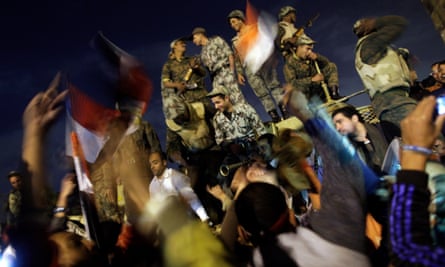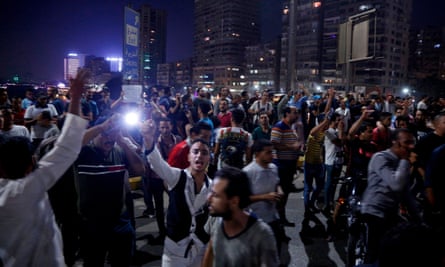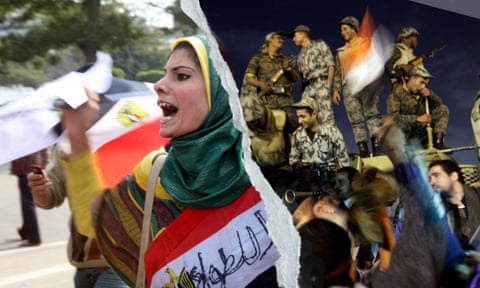In the centre of the place where it all began, Mansour Mohammed manned a tarpaulin-covered stall on the only green grass among miles of concrete and asphalt. For 10 days he ate and slept huddled with strangers bound together by burgeoning rage and revolt all around. Enormous crowds heaved and surged – roaring their demands for change in a call that resounded through Tahrir Square in Cairo. “I’ll never forget that sound,” he said. “It was the most powerful noise I’ve ever heard. It was louder than 10 jumbo jets. It was the release of six decades of fear.”
A decade on, the launchpad of Egypt’s revolution – a seminal part of the uprisings which became known as the Arab spring – is a very different place, as is the country. The strip of grass has been concreted over and on it stands a newly erected obelisk, pointing skywards in a trenchant reminder of times of staid certainty. Traffic moves sedately around a roundabout now free of protesters or attempts at defiance. Secret police are positioned, not so secretly, nearby. There is little talk of revolution, and attempts to stir the ghosts of Tahrir Square are met with the heavy hand of the invigorated military state that entrenched itself in the revolution’s wake.

It had started very differently for Moaz Abdulkarim. On the 25 January, 2011, he and a group of young Egyptians gathered in flats on the other side of the Nile and made their way to a pastry shop, where they prepared to change history.
The location was out of the reach of police trucks and off the grid for security chiefs who had been scanning the city for subversives energised by the uprising in Tunisia that had forced the dictator Zine al-Abidine Ben Ali into exile weeks earlier.
The neighbourhood’s narrow lanes gave them time to organise and build numbers before riot police could storm them. And they had the jump on their pursuers in another – more significant – way: by mobilising supporters on social media platforms, the extraordinary reach of which would soon shatter the illusion that President Hosni Mubarak’s forces were too powerful to confront.

Early that morning, the group assembled at El Hayiss pastries and set their plan in motion. “The meeting in the bakery was just one step of the plan,” said Abdulkarim, who now lives in exile in Europe. “There were many different groups [to co-ordinate with] and our group’s mission was to stay in the bakery in Mustafa Mahmoud Square. We watched the police to see if they would attack the protesters.
“We were thinking if we can succeed then we will have a better Egypt and if we fail then we will die or spend all our life in jail. In my lifetime only Mubarak was president so I always had a dream to see another president from another family.
“Our job was to bring all the protesters together so the police could not control them. If there were only a few protestors the police simply could arrest them and this would make it fail. There were soon around 2,000 people and the police couldn’t control the situation. At that moment I realised that we succeeded, because I saw people of all types; different economic levels, rich and poor, old and young all standing together with one voice.”

By then, calls over social media for crowds to gather in areas of Cairo, and converge in public spaces had built an unstoppable momentum. “Social media was the most important tool in the revolution,” said Abdelkarim. “People could communicate very easily and express themselves without any censorship.” Mubarak’s police state was over run by dissenters with smartphones and Facebook accounts.
By 28 January, Tahrir – or Liberation Square – had become the crucible of relentless demands for a new Egypt. And within two weeks, it had set the seeds for Mubarak’s demise. The then US president, Barack Obama, withdrew Washington’s long support for the Egyptian leader, who had ruled for 30 years, and endorsed Egypt’s revolutionaries. “Egyptians have made it clear that nothing less than genuine democracy will carry the day,” Obama said.
Then came a challenge to Egypt’s military, which had stood with the revolutionaries as their demands grew louder. “The military has served patriotically and responsibly as a caretaker to the state,” said Obama. “And will now have to ensure a transition that is credible in the eyes of the Egyptian people.”
“He didn’t know it at the time, but his words were an epitaph,” said Salwa Jamal, a supporter of the revolt who was forced to flee Egypt in 2014. “From that moment, the military were planning to take over.”

Nancy Okail, an Egyptian activist and scholar, said the day of Mubarak’s resignation, 11 February , revealed that the coming months were to be anything but a seamless transition to democracy. “It was the worst moment for me,” she said. “I saw the tanks and knew that the military were taking over. I saw people giving the military flowers, cleaning the streets and wiping way the graffiti. It was the beginning of wiping away traces of the revolution.
“Throughout it all, people were saying no, no the military is on our side. But we knew them and we knew how they run things.”

In 2012, democratic polls were held and the Egypt’s first democratically elected president, Mohamed Morsi, a member of the powerful Islamist group the Muslim Brotherhood, took office. He soon made declarations to give himself more power and dissatisfaction with his government fast grew.
Less than a year later, Morsi was removed in a coup led by the then defence minister, Gen Abdul Fatah al-Sisi, who dissolved parliament and banned the Muslim Brotherhood. A crackdown on dissent, which continues today was launched, and Sisi was elected president in two elections.

Ever since, Egypt’s new leader has attempted to rub out all vestiges of the revolution using overwhelming repression to crush calls for change. Civil society in Egypt has been decimated, its artists, intellectuals, journalists and academics largely forced into silence, or exile – or imprisoned. Political opposition has also been hobbled, or coopted, and international condemnation has long since been muted. In early December, the French president, Emmanuel Macron, presented Sisi with the Legion of Honour, France’s highest civilian award, overlooking a human rights record that global NGOs have described as diabolical.

Sisi’s claims to help stem migration to Europe and to be a bulwark against security threats have won tacit support and his routine suppression of dissent and expression have led to minimal consequences and impunity. Human Rights Watch said there were 60,000 political prisoners in Egypt in 2019.
Despite the crackdown, Khaled Mansour, a former Executive Director for the Egyptian Initiative for Personal Rights said many who supported the revolution would do so again. “It was still definitely a turning point, he said. “But we don’t always turn towards a position of comfort, or in a good direction.”

He added: “The only thing they have that allows them to stay in power is force. Social cohesion, being an economic saviour, terrorism, national security threats; all enable these agencies to say ‘we are the last redoubt’ and to postpone any talk of change.
“What we need is not a united Egypt, but a place where different factions can talk with each other and engage in political dialogue without existential fears overriding things. Can we heal? It is going to take a long period of self-critique and introspection, and that is extremely difficult to happen now.”
